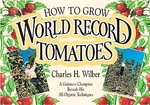
I apologize for those of you who aren't gardeners, if you feel I'm writing too many post with that as my topic, but I find plants fascinating, and hope that even if you don't garden you can enjoy hearing about all the wonderful things that God has designed plants to do.
I just wanted to tell you about a really interesting book Dad recently got out of the library: "How to Grow World Record Tomatoes," by Charles H. Wilber.
This book is informative, funny in parts, clear, and well-written in general. Like all books, it must be read with a grain of salt, but you can't help getting excited by what you read.
Dad really couldn't wait to get his hands on this book. He had it on hold for a while at the library, and mentioned nearly every day how eager he was to read it. He even researched it on the Internet to get some previews of what it was going to be like!
This author really did grow world-record tomatoes, and his methods sound very logical. Dad and I both agree that it will be fun to test the ideas when the tomatoes get planted next spring. It's a little late to use all his ideas now, since many have to do with the way you plant, but there are a couple we can use - such as lots of compost.
Even Mom sat down and browsed the book. Mom has gardening flowing in her veins, since her father is a wonderful gardener, but although she does her share of caring for the plants, 'specially preserving them, she doesn't usually read through gardening books. I guess a book with tomato trees on the front cover is a worthy temptation!
Plants raised with Mr. Wilber's methods have produced more than 300 lbs. of tomatoes in one year. He considers under 100 pounds off of his plants to be a harvest failure! They grow over 20 feet high, and are less sensitive to frost at the end of the year, so they produce longer.
A few points that he makes:
~ Use LOTS of water. I mean lots. And don't use tap water, or water from your hose. Use rainwater or water from a pond, lake, or river. The other stuff is treated with things that could kill microorganism in your soil.
~ Use LOTS of compost.
~ Prune wisely. He gives a detailed method for deciding exactly what parts of the plant to remove, and lists 18 branches as the ideal number to have on one plant.
~ Support your plant correctly. He uses wire dog fencing.
There are many other neat suggestions in this book, and if you're growing tomatoes, or want some interesting reading, ...or just want to see some photos that make your mouth drop, then see if you can get a copy of this book!
P.S. For those of you who prefer sewing to gardening, take heart! As soon as I finish a few more of my many projects, I plan to show you some of my additions to my summer wardrobe.


.gif)

No comments:
Post a Comment